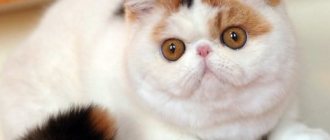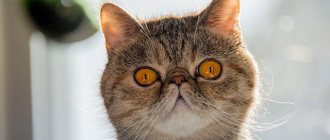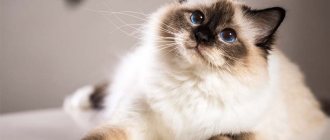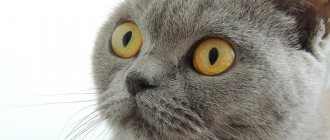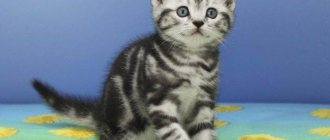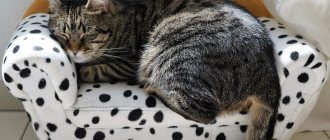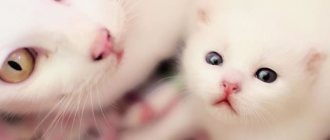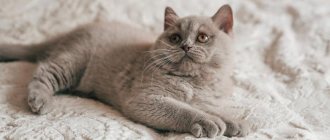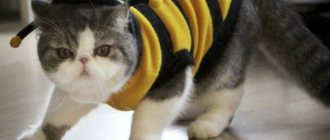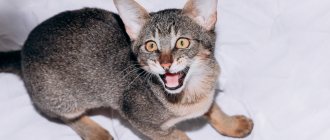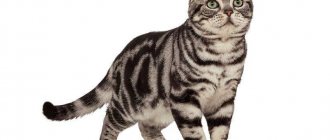History of the Exotic Shorthair cat breed
Exotic Shorthair cat
The appearance of the Exotic Shorthair breed dates back to the 50s of the last century. Frankly speaking, the first kittens appeared completely by accident. Wanting to get new coat colors and eye colors, American Shorthair breeders crossed their pets with Persian cats. Another goal of these attempts was to make the physique of “American women” more dense. The task was not solved. The offspring, to the surprise and disappointment of the breeders, turned out to be very “Persian” - all the animals were born with characteristic “doll” faces. And in other respects, the kids were more like their parents “from the East.” Only the fur became noticeably shorter and acquired a denser, plush structure. As a result of crossing, it was not possible to improve the American Shorthair cat breed, but completely new kittens with an outlandish appearance were born.
Already in 1966, Jane Martink introduced a new breed, which was given the name “Exotic Shorthair”. The accidentally bred cats took a long time to achieve recognition. Ambitious people were critical of “exotics”, believing that they encroached on the purity of this breed. It got to the point that they refused to mate their elite pets with exotic shorthairs, and they did this consciously and in an organized manner. Fortunately, there were far-sighted owners of the “Persians” who saw the prospects and took part in the selection. Among them, special mention should be made of Doris Walkinstick and Caroline Bussey, whose merits in the formation of a new breed can hardly be overestimated.
Representatives of the Russian Blue breed and Burmese cats were also used in breeding work. The experiments were stopped only when the shorthair gene was firmly established. Since then, matings of exotics have been possible only with Persians.
In 1990, felinologists came to an agreement that the breed standard completely duplicates all the requirements for the Persian cat, with the exception of the length and quality of the coat. Based on these agreements, all changes that are made to the Persian breed standard automatically become relevant for the exotic shorthair cat.
Breeding
To breed an exotic breed, you need to have not only the desire, but also documents permitting such activities. This must include pedigrees of the producers, membership in a recognized cat breeding society, and documents from the breeder.
The purpose of breeding exotics is primarily to improve the breed, and not to increase the number of animals.
Mating of exotics is allowed directly with exotics and Persian cats. The cat must meet all breed standards without a single deviation, just as the father must meet the standards of his breed. High-breed cats are allowed to mate at the age of 1 year. Mating more than once every 2 years is prohibited.
In newborn kittens, it is impossible to immediately determine the length of the fur. The first signs appear in babies only at 2-3 weeks of life - the tail of long-haired exotics resembles a panicle. The final length of the coat is visible only at the end of the second month of life - plush exotics look disheveled and awkward.
There are several nurseries in Russia that breed exotic kittens:
- ASSOREL - Eagle;
- LumiCat – Moscow;
- COLOROLLA – Severodvinsk;
- Belinka Cattery – Nizhny Novgorod.
Exotic appearance
Exotic kitten
The ideal exotic shorthair cat looks like a well-balanced animal with strong, even somewhat heavy bones. The coat gives the outline softness and roundness, the expression of the muzzle conveys complacency and calmness of character.
Head
Round in shape, quite massive. The skull is very wide with a round bone structure. The chin is well developed and round in shape. The jaws are strong and wide, the cheeks are full.
Eyes
The eyes of an exotic cat are located far from each other at the same level. The shape is large and round.
Ears
Small size, round shape. Set wide and low on the head, slightly tilted forward. Not very open at the base.
Nose
Wide, short and upturned. “Stop” is located clearly between the eyes.
Exotic cat face
Body
The body of exotics is medium or closer to large in size. Squat, with well-developed muscles, without signs of obesity. The chest is wide, the shoulders are massive.
Limbs
Exotic standing on his hind legs
Strong, short, massive. The front ones are straight, the rear ones are straight when viewed from behind.
Paws
Exotic paws are large and round. There are 5 toes on the front paws, 4 on the hind paws.
Tail
Proportional to body length, although it can rather be defined as short. No bends. The animal is held at a level below the back.
Wool
The exotic cat's coat is thick and plush, with a rich undercoat. Middle length. It feels very soft to the touch.
Disqualifying features
Visible weakness of the hind limbs, tail defects, number of toes that does not meet the standard. Strabismus, asymmetry of the muzzle or head. Visible deformities of the spine. White toes and non-blue eyes for color points.
Appearance and character of exotics
An exotic is a large cat with powerful and strong bones.
The appearance must meet the following criteria:
- Torso. The skeleton is strong and heavy. The cat looks massive and squat.
- Limbs. Shorter than other cats, thick and powerful. The paws are round, bunched into a dense ball, and there are tufts of hair between the toes.
- Tail. Not long, well pubescent, thick at the base. The tip is slightly rounded.
- Head. Large, massive, round in shape. Exotics have a wide skull with a convex forehead. The cheeks are rounded, the nose is flattened.
- Ears. Triangular, wide set. They are small in size relative to the head, the tips are rounded.
- Eyes. Expressive, large. Widely spaced. The color of the iris should match the color of the coat.
The fur of exotic cats is plush to the touch, short and soft. It does not adhere to the body due to the thick undercoat.
Exotic fur has a plush feel to the touch.
The color can be anything except cinnamon (cinnamon color) and fawn (light beige). The breed is not hypoallergenic, so before getting a pet, you need to make sure there are no allergies.
Interesting! The weight of an adult exotic can reach 7-8 kg.
Exotic shorthairs are inquisitive and cheerful animals.
They have a soft and calm character, are happy to make contact, love affection, but at the same time they are unobtrusive and patiently wait for the owner to pay attention to them.
Be sure to read:
What are the different colors of Bengal cats?
The exotic looks closely at strangers for a long time , but if he likes the person, he will reciprocate the affection. These animals rarely show aggression.
Cats become very attached to their owners and need constant contact with them. They willingly accompany their owners on trips and tolerate long trips well. Their behavior resembles that of dogs.
Exotic shorthairs get along well with children and pets. They can live both in an apartment and in a private house.
In the area, the exotic cat prefers to lie on the grass and rest; such cats rarely catch mice.
Education and training
Exotics have developed intelligence and are able to remember simple commands.
Exotics have developed intelligence and are able to remember simple commands
They begin raising the baby immediately after he moves to a new home. During the training process, physical impact and aggression should be avoided.
Attention! It is necessary to communicate with an exotic person gently and patiently. Threats and intimidation will cause the kitten to permanently lose trust in its owner.
Education involves training your pet to use a scratching post and a litter box. The scratching post can be sprayed with valerian or catnip infusion so that the pet shows interest in it. If the animal begins to sharpen its claws on the carpet or furniture, it is immediately taken to the scratching post and praised if the pet has used it.
Filler is poured into the tray, and then the baby is placed in it and digging movements are made with the front paws. It is necessary to closely monitor the kitten and, as soon as it begins to look for a place to relieve itself, transfer it to the tray.
After the baby goes to the toilet, he is praised and treated with his favorite treat.
How long do exotics live?
The Exotic Shorthair is considered mature at the age of 2-2.5 years. With proper care, an animal of this breed will live even up to 20 years, but the average life expectancy is 12-15 years.
Exotic photo
What types are there?
Exotic cat breeds have the following varieties:
One of the varieties of exotics is the shorthair, which has the features of a British cat.
- Smooth-haired. They look like short-haired Persian cats with the external features of a British cat. The animal is distinguished by wide bones and powerful legs.
- Exotic long-haired cat. Looks like a Himalayan cat, but lacks the point coat colors. Exhibition copies are classified as Persian.
- Persian extreme. It is a subspecies of the breed. These cats have a small snub nose.
Character of an exotic cat
The character of the exotic shorthair is in amazing harmony with her charming appearance. Friendliness, calmness and complaisance make this animal a wonderful friend and companion. Pets are capable of sincere affection for their owner, but they show their feelings so delicately and subtly that they cannot be called intrusive. They will wait patiently until you finish your business, and only then will they remind you of their presence with a gentle, calm purr. Don't forget to give your friend enough time, because these cats can hardly tolerate loneliness.
With such a “cartoonish” and even somewhat clumsy appearance, exotics are quite active, inquisitive and agile. Moreover, showing natural curiosity, cats of this breed are able to lose their sense of danger. To avoid unpleasant or risky situations, try not to leave your pet alone for a long time. Both kittens and adult animals are playful. Many owners of exotic cats also note that they have well-expressed hunting instincts.
Adaptation of exotics to new conditions due to their livable nature does not present any particular difficulties. Your household, as well as pets already living in the house, will easily find a common language with this cute creature if they are in a positive mood.
Exotic shorthair cats have virtually no manifestations of aggression - in order to bring them out of a state of mental balance and serenity, you need to really want it. The manifestation of hostility, and even then in the form of attempts to avoid close contact, is possible only towards strangers.
Relationships with younger family members almost always go well. Exotics themselves love to play and will gladly take part in children's fun. All you have to do is control the degree of activity and safety of the game on the part of the “human cubs”.
From the point of view of a combination of character traits, temperament and intelligence, the Exotic Shorthair can rightfully be considered a cat ideal for home keeping.
White exotic nestled on the sofa
Owner reviews
At a young age, such pets simply amaze with their curiosity and mobility. Over time, growing up, exotics acquire the features of respectable pets, with the manifestation of laziness, which is associated with constant rest, especially lying on their backs. At the same time, the cat will not mind if the owner scratches her belly area.
The advantage of the breed is that the mature age of cats begins at 2 years of life, while the sexuality of the breed is quite weak compared to other cat breeds. After fertilization, a cat can give birth to both short-haired and long-haired kittens. Short-haired individuals do not require special coat care.
These pets sometimes show selectivity in food. At one point, the cat refuses its favorite treat and begins to beg for something tasty. If such a cat regularly visits the street, it prefers to stay close to the entrance or on the porch. She does not get involved in any confrontations with yard cats. Sometimes they sit in an apartment for months, and then suddenly change their living conditions, coming home only to eat and spend the night.
Interesting moment! The exotic shorthair cat is loved by everyone, especially children, who agree not to let such a pet out of their hands. As for the cat herself, she does not like such annoying behavior from children and will try to sneak away at the first opportunity.
The exotic shorthair cat is a unique artificially bred animal. In order for her to become a real favorite for the whole family, she needs to be looked after, as well as shown attention and care. As a rule, love is always answered with love, which is true in relation to our smaller brothers. Despite the fact that they have their own language of communication, they very sensitively feel how their owner and family members treat them.
Education and training
Red bun
The Exotic Shorthair cat is very intelligent, perceptive and trainable. Practice has shown that exotics are able to remember simple commands and prohibiting words. To achieve lasting results, it makes sense to start training from the day you bring the kitten into the house. To make it easier to learn the simplest commands, you can accompany them with short exclamations or simply clap your hands.
The main rule of training is no aggression. The psyche of exotic cats is very sensitive, so you won’t find a better training method than love and patience. By forcing an exotic kitten to do anything through force, threats and intimidation, you will not only permanently lose his trust, but also cause serious harm to the baby's health.
Educational moments—training a kitten to use a litter box and a scratching post—usually pass without much difficulty. It is better to place the toilet in a quiet place where no one will distract your pet from his business. And so that your baby quickly understands the purpose of the scratching post, try spraying it with valerian tincture or a special product purchased at a pet store.
Keeping Exotic Shorthair
The Exotic Shorthair is an unpretentious breed.
Hygiene
The short coat of exotics does not require special and regular care; it is enough to comb it once every 2-3 weeks with a soft rubber brush.
The short coat of exotics does not require special and regular care.
You should also follow these care rules:
- Bathing. The pet is washed once every 1-2 months. To do this, it is recommended to use special professional shampoos for short-haired cats, for example, Show Tech Pure Coat, Iv San Bernard, Laser Lites Duo Shampoo, etc.
- Eyes. Due to the structure of the muzzle, the eyes of exotics may become a little watery. The formation of tear tracks is considered normal. The area around the eyes is wiped daily with a cotton pad moistened with a special tonic. Canina Augen Pflegelotion, Baldcecchi Lineagatto, eye cleansing lotion, etc. are suitable for this procedure.
- Claws. Twice a month the pet's claws are trimmed. To do this, use a special nail clipper, which is used to cut off 2-3 mm of the tip of each claw.
- Ears. They are cleaned as needed. Normally, the skin on the inner surface of the ear is covered with a light, almost colorless coating. If heavy discharge or flakes appear in it, you should contact your veterinarian.
Be sure to read:
Short-haired and smooth-haired cat breeds: names of breeds with photographs
Exotic animals are accustomed to all hygienic procedures from childhood. These cats do not resist manipulation and calmly allow it to be carried out.
To rest, your pet should be provided with a comfortable and soft corner.
Your pet should be provided with a comfortable and soft corner to rest.
It is better to purchase a ready-made soft house or a fluffy bed, closed on all sides. It is placed in a secluded place where no one can disturb the exotic animal.
Important! Strong nets must be installed on the windows. Exotics are very curious and can easily fall out of an open window, and due to their large size, they will suffer serious injuries if they fall.
Feeding your pet
Exotics are prone to gaining excess weight , so it is important to choose the correct daily food intake. As the main diet, it is better to choose ready-made food of premium class and higher. Exot can be fed with the following brands of food: Applaws, Organix, NOW, etc.
Exotics are prone to gaining excess weight
If you want to pamper your pet, offer him wet food of the same brand. From natural food, exotics are given scalded meat (veal, turkey), sea fish without bones, and fermented milk products.
Exotic health: diseases and vaccinations
Exotic Shorthair cats may have the following genetic diseases:
- obstruction or narrowing of the nasolacrimal duct;
- diseases of the teeth and gums (tartar, gingivitis, periodontal disease, etc.);
- polycystic kidney disease;
- hypertrophic cardiomyopathy;
- overshot, or displacement of the lower jaw.
Exotics, like other cats, can suffer from a virus or infection. It is very important to observe prevention in the form of regular annual vaccination with Quadriket, Nobivak, Purevax, etc.
If you want to pamper your pet, offer him wet food
10-12 days before the procedure, the pet is given an anti-helminth drug (Prasitel, Kanikvantel, Milbemax, etc.).
Castration and sterilization
If the exotic will not take part in breeding, it is better to spay or neuter him. This procedure is carried out in a veterinary clinic. The animal is given general anesthesia, and then the testes are removed in cats or the uterus and ovaries in cats.
The appropriate age for castration and sterilization is 6-8 months. Some breeders perform this procedure on young kittens aged 9-12 weeks.
Preliminary examination of the pet:
- do an ECG to assess the functioning of the heart muscle;
- donate blood for general and biochemical analysis;
- submit urine and feces for examination.
Only a completely healthy animal can be spayed or neutered. After such an operation, your pet’s hormonal levels will change, causing him to have a tendency to gain excess weight.
For this reason, it is necessary to change the exotic diet. It is better to switch him to ready-made dry food marked Sterilized or Light.
Care and maintenance
The exotic shorthair cat is an absolutely unpretentious creature. Professional grooming is not required, which is why representatives of the breed are sometimes called “Persians for the lazy.” But this does not mean that you don’t need to take care of your fur coat. The coat of exotics is very thick, voluminous, soft and well balanced with a soft undercoat. To keep the coat looking healthy and beautiful, you should comb it two to three times a week using a special high-quality metal comb. Like other felines, exotic shorthaired cats take care of their appearance by licking themselves, which is why experts recommend having a means to remove hairballs from the stomach in your veterinary medicine cabinet.
Combing an exotic's fur
Exotics need systematic bathing, at least once a month. The structural features of the animal's face require careful and attentive care - wipe it daily with a damp cloth, paying special attention to the condition of the eyes and tear ducts, as well as the cat's nose. Don't forget to trim your pet's nails twice a month using a safe nail clipper. It is unnecessary to remind you about the mandatory presence of a scratching post.
Provide your pet with a comfortable, safe place where he can rest peacefully. If this is a house, then purchase it in such a way that the animal has enough space to lie down, curled up in a ball or stretched out to its full length. Move your exotic cat closer to you - the pet does not tolerate loneliness well. Some representatives of the breed love to sit or lie for long periods of time on cool surfaces, such as tile floors. To prevent your animal from catching a cold, try to limit the time of these “cooling” procedures.
Om-Nom-nom
If you do not live on the ground floor, make sure there are protective nets on the windows. Exotic shorthairs are large animals, in some ways even obese, and a fall from a height can lead to the most severe consequences.
When deciding on nutrition, remember that adult animals are prone to obesity. To avoid such problems, teach your pet a proper, balanced diet from an early age. Immediately put a taboo on fatty foods and goodies from the common table. The diet should be based on protein products in organic combination with cereals, vegetables and vitamin complexes. The use of premium dry ready-made food from leading manufacturers is completely acceptable.
Important: if you use both dry food and natural products, never combine them. You can alternate, but you can mix – no!
Breed card
| Characteristics of a cat | Notes | |
| General information | Beautiful cats that resemble short-haired Persians with a characteristic face | Bred in England from British Shorthair cats and Longhaired Persians |
| Character | Calm and balanced cats love to be petted and caressed | |
| Appearance | Flat muzzle with upturned nose. Short and powerful limbs with round paws. Plush, short and soft coat, a variety of colors | |
| Behavior at home | He likes to be at home and is not very happy to go for walks. Playing with toys according to your mood | |
| Care | Combing the coat once a week, 2-3 times during shedding | If you neglect regular brushing, the undercoat may become matted. |
| Health problems | Due to deformation of the tear ducts, they suffer from discharge in the corners of the eyes, which must be removed periodically | |
Health and disease of the exotic shorthair cat
Black Exotic
Exotic Shorthair is an artificially bred breed, which in essence is no different from its relatives - the Persians (except for the length and structure of the coat). It is absolutely logical that the genetic diseases in these two breeds are almost identical.
The most common diseases of the respiratory system and eyes occur in exotic animals. The reason is obvious - the unusual structure of the muzzle and the associated deformation of the nasolacrimal duct.
A genetic predisposition to kidney disease and cardiomyopathy is clearly visible. The latter disease very often causes the death of animals of this breed at an early age.
The oral cavity of the exotic can also be considered a risk zone, and a fairly high one at that. Without proper care of your gums and teeth, gingivitis, periodontal disease and other inflammatory diseases may occur. Sometimes cats have abnormally developed lower jaws, which can lead to problems eating.
The best prevention of the occurrence or complex course of these and other diseases is proper care and careful monitoring of your pet’s condition. Timely vaccination, deworming, preventive examinations at a veterinary clinic - all these simple measures will help you avoid unnecessary problems and maintain the health of your exotic shorthair cat for many years.
Table: pros and cons of the breed
| pros | Minuses |
| Friendly calm character | Discharge from the nose and eyes is often observed due to their specific structure |
| Attachment to people | There is a lot of wool, which is difficult to care for |
| Beautiful appearance | Little physical activity |
| Lack of aggression | There is a possibility of genetic diseases |
Video: exotic shorthair cat
How to choose a kitten
Exotic cat
Life shows that in most cases we buy a cat “for the home, for the family,” so personal sympathy often becomes the main selection criterion. If you are planning to buy an exotic cat to participate in exhibitions or want to seriously engage in breeding, then the selection criteria will be much stricter - it must be a breed or show class kitten, from titled parents with the appropriate documents.
However, in both cases, you must carefully evaluate the external indicators of the baby’s health: feel the tummy, look in the ears, mouth and even under the animal’s tail. It is useful to observe the behavior of your chosen one for some time in order to make at least rough assumptions about his temperament.
You should know that the combination of certain signs in kittens of an exotic breed may indicate the presence of genetic problems. For example, a blue-eyed white creature with a high degree of probability may suffer from hearing loss, or even be completely deaf.
We do not recommend buying a baby who is not yet 3-3.5 months old. By this age, as a rule, breeders have completed the first scheduled vaccination, including the period of mandatory post-vaccination quarantine. Kittens at this age already have certain hygiene skills, and their gastrointestinal tract is ready for the transition from mother's milk to “adult food”.
Before buying an exotic, you should familiarize yourself with the characteristics of the breed, all its pros and cons, in order to make the right choice.
History of exotics
The breed dates back to the 1960s. The breeding of unusual cats happened by accident, since the original goal of the breeders was to improve the qualities of the American Shorthair by crossing with Persians. The main goal was to improve the quality of wool and obtain a wider range of colors. However, as a result of such mating, the offspring turned out to have an exotic appearance - short legs and neck, thick build, characteristic muzzle, snub nose. But despite the large number of traits inherited from the Persian breed, exotics did not receive long hair.
The Exotic Shorthair has been officially registered with most major cat associations. Initially, a proposal was put forward to name the breed “sterling”, that is, “silver”, however, this idea was abandoned.
Photos of exotic kittens
Psychology
Exotics have a calm disposition, although young individuals occasionally run “races” around the house, flexing their powerful muscles.
In addition, Snoopy is silent; they rarely give voice, only when they really need something.
Exotics are selective in their affections and at first look closely at their owner.
However, if you manage to find a rapport with the plush charm, you will receive almost dog-like affection.
An exotic cat needs communication and becomes attached to a specific person.
You can read about other sociable cat breeds here:
This may cause some inconvenience if you need to leave your pet - exotic cats, unlike Scottish Straights or Scottish Folds , feel sad when separated.
But they can handle any type of transport well and travel willingly.
If you already have other pets - cats or dogs - in your house, the conflict-free Snoopy will become an excellent companion cat for them.
Yes, yes, the exotic cat can read. You can discuss a book you recently read with him. True, he will keep his opinion to himself
How much does an exotic cat cost?
The price of an exotic kitten depends on several factors. These include:
- compliance with the breed standard;
- “purity of blood” - the more elite the parents, the more expensive the kittens;
- color, its rarity and fashionability;
- routine vaccination carried out.
Prices in professional nurseries are objectively higher than those of private breeders. You can buy exotics even cheaper online or at the poultry market. Although in the latter case, a certain cheapness is more than compensated for by the possible numerous risks. There are even known cases of selling a simply cut Persian kitten instead of an exotic shorthair.
We recommend contacting trusted breeders or nurseries, where the average price of an exotic shorthair kitten, depending on the class, can range from 7,000 to 50,000 rubles.
Purchasing a kitten
If you want to buy an exotic shorthair kitten, you first need to study the characteristics of the breed, perhaps visit specialized exhibitions, communicate with breeders and simply fans of the breed.
How to choose a kitten
An exotic kitten should be purchased exclusively from a trusted, conscientious breeder with a good reputation. Since exotics, like Persians, are an artificially bred breed, they may experience some health problems. Conscientious breeders will never sell a problem or sick animal, as they care not only about their own reputation, but also about the health of their pets.
Criterias of choice
When choosing an exotic, you need to pay attention to the proportionality of the baby. These breed characteristics become visible already at the age of 3 months:
- The kitten should have a large skull, without any depressions or asymmetries.
- The tail is straight, without any bends.
- The fur is of medium length, not adjacent to the body, ivy in appearance. If the hair is so long that it adheres to the body, the future owner may be faced with a representative of a long-haired exotic, which can be born from the most thoroughbred parents.
- The kitten's eyes should be large and expressive. Particular attention should be paid to their cleanliness. If your baby's eyes are sour, this may be a sign of illness.
The eyes of exotics have been large and expressive since childhood.
- The bite of a small exotic must be correct, without overbiting the front jaw, without facial asymmetry, in which one of the fangs protrudes.
- And, of course, the baby should be active, playful and inquisitive. It is best to monitor his behavior in a nursery, where the kittens are in a familiar environment and behave naturally. At the same time, it will become clear in what conditions the animals are kept, how healthy the environment is in the house, and whether there are one or more sick cats nearby.
Kitten age
Experts and breeders strongly recommend purchasing exotic shorthair kittens no earlier than 3.5 months of age. At this point, little exotics are fully vaccinated, can eat on their own, and are litter box trained. At the same time, you can already see whether the short-haired exotic baby in front of you or a representative of the breed with long hair.
It is best to purchase an exotic baby at the age of 3.5 months
But experts everywhere consider the age of 1.5–2 months recommended for purchasing kittens to be too early. At this time, the animal is not yet ready to tear itself away from its mother.
